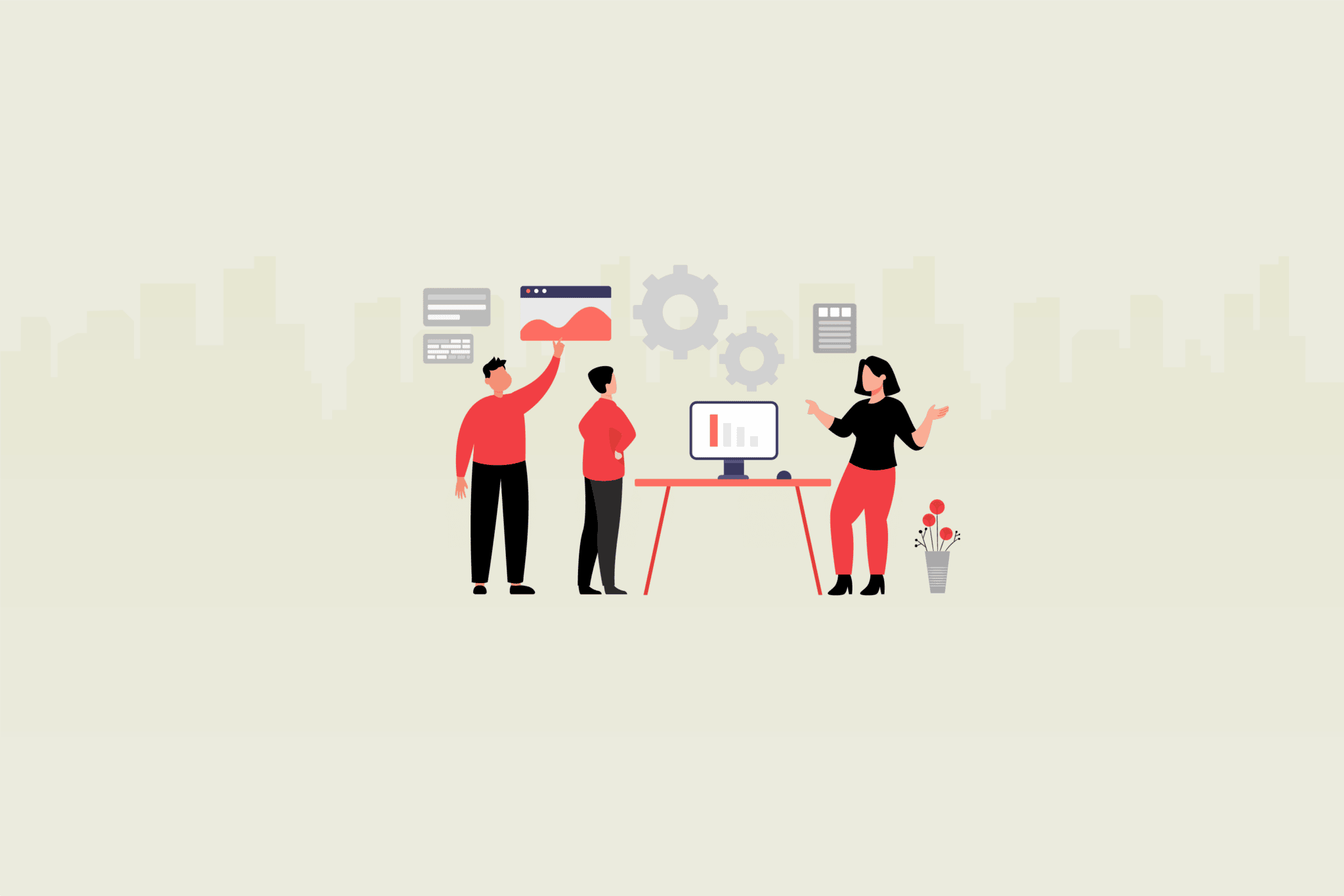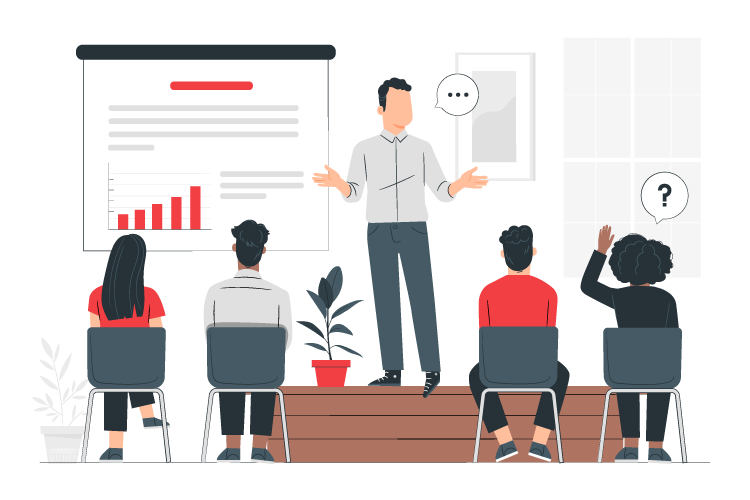According to SHRM, 69 percent of employees are more likely to stay with a company for three years if they experienced great onboarding.
Welcoming new employees to your company is an exciting opportunity to lay the foundation for their success and integration within your organization. A well-crafted new hire orientation program serves as a crucial stepping stone for their journey, providing them with the knowledge, tools, and connections they need to thrive in their new roles. In this blog, we’ll delve into the intricacies of designing and delivering an effective new hire orientation experience that not only imparts essential information but also fosters a sense of belonging and engagement. From planning and content creation to interactive methods and technology utilization, we’ll guide you through the process of creating an onboarding program that sets the stage for long-term employee satisfaction and productivity.
Understanding the importance of a new hire orientation program
In the dynamic landscape of modern workplaces, the significance of a well-structured new hire orientation program cannot be overstated. This critical initial step in the employee onboarding process sets the tone for an individual’s experience within the company and significantly impacts their long-term engagement, productivity, and overall success.
The primary goal of a new hire orientation program is to acclimate freshly onboarded employees to the organization’s culture, values, and operational procedures. Beyond a mere introduction to the company premises and team members, this process encompasses the broader context of an employee’s role in the organization’s mission. By providing insights into the company’s history, goals, and core values, the orientation program establishes a sense of purpose and belonging from day one.
Moreover, the new hire orientation experience is a prime opportunity to communicate expectations, policies, and guidelines clearly. This not only helps new employees understand their responsibilities but also ensures alignment with the company’s ethical standards and operational procedures. Clarity in these aspects not only promotes adherence but also fosters a safe and respectful work environment for everyone.
A well-executed new hire orientation program has a direct influence on the overall employee experience. It reduces the time it takes for new hires to become productive contributors and minimizes the stress associated with adjusting to a new workplace. Additionally, it aids in reducing turnover rates by enhancing employee satisfaction and engagement, thereby saving the company resources that might have otherwise been spent on frequent recruitment and training.
In conclusion, recognizing the pivotal role that a thoughtfully designed new hire orientation program plays in an organization is essential for creating a positive onboarding experience. Beyond the initial information transfer, it nurtures a sense of connection, understanding, and purpose among new employees, ultimately contributing to the company’s growth, stability, and employee retention.
Planning for a seamless new hire orientation
Crafting a successful new hire orientation program requires meticulous planning and strategic foresight. This phase serves as the foundation for an engaging and effective onboarding experience that ensures new employees are equipped with the knowledge and tools they need to excel in their roles from day one.
The initial step in planning an orientation program involves identifying the key objectives and outcomes you aim to achieve. Are you focused on introducing company culture, job-specific training, or a combination of both? Clarifying these goals guides the rest of your planning process.
Equally important is understanding your audience – the new hires. Tailoring the orientation to their needs, backgrounds, and experiences ensures relevance and engagement. Consider factors like previous industry knowledge, skill levels, and preferred learning styles when designing the content and delivery methods.
A well-structured timeline is essential. Decide on the duration of the new hire orientation – whether it’s a full-day program, spread over a week, or integrated into the first few weeks of work. This timeline should balance the need to cover essential information with allowing new hires time to absorb and process the information.
Collaboration among various departments is crucial during planning. HR, team leaders, department heads, and even current employees can contribute insights and expertise that enhance the content and approach of the program. This collaborative effort not only enriches the orientation but also establishes a sense of community involvement.
Lastly, evaluation mechanisms must be integrated into the planning phase. Defining how you will measure the success of the new hire orientation program allows you to gather feedback, identify areas for improvement, and make necessary adjustments for future iterations.
In conclusion, the planning phase of a new hire orientation program lays the groundwork for a seamless and impactful onboarding experience. It aligns objectives, customizes content, establishes a clear timeline, promotes collaboration, and sets the stage for ongoing improvements. By investing time and effort in this stage, you ensure that your orientation program is not just informative but transformative for new employees and your organization as a whole.
Tailoring content for a comprehensive new hire experience
Creating a new hire orientation program that resonates with your employees requires a thoughtful approach to content development. Beyond the standard operational information, a comprehensive program should encompass a blend of company culture, policies, and role-specific training to give new hires a well-rounded understanding of their place in the organization.
Begin by focusing on conveying your company’s core values, mission, and vision. This forms the bedrock of your organization’s identity and provides a context for new employees to align themselves with the bigger picture. By showcasing success stories, emphasizing company values, and introducing key stakeholders, you set the stage for a deep connection.
The orientation program should also delve into the practical aspects of working within the company. Cover HR policies, code of conduct, and any compliance-related information. This section ensures that employees are well-informed about their rights, responsibilities, and the ethical standards expected of them.
Tailor the training to meet specific job roles. While general onboarding sessions provide an overview, role-specific training drills down into the skills and knowledge required for success. These sessions can be conducted by department heads or team leaders who are well-versed in the intricacies of the role.
Engagement is key. Make the content interactive and engaging, incorporating multimedia, group discussions, and scenario-based exercises. This approach not only holds participants’ attention but also encourages active learning and collaboration.
Lastly, gather feedback on the content from current employees. Their insights can reveal gaps, offer suggestions, and provide a more holistic perspective on what new hires truly need. Continuous refinement ensures that the content remains relevant and impactful.
In conclusion, a well-tailored new hire orientation program weaves together elements of culture, policy, and role-specific training. By addressing both the aspirational and practical aspects of employment, you empower new employees with a comprehensive understanding of their place in the organization and facilitate a smoother integration into the company’s fabric.
Engaging delivery methods for new hire orientation
The effectiveness of a new hire orientation program hinges not only on the content but also on the methods used to deliver that content. To create an engaging onboarding experience, organizations must employ a variety of delivery methods that cater to different learning styles and preferences.
In-person sessions remain a staple in many new hire orientation programs. These sessions provide an opportunity for direct interaction with facilitators and fellow new hires. They offer a platform for questions, discussions, and real-time clarifications, fostering a sense of community and shared learning. Such sessions can cover general company information, values, and introductions to key personnel.
Online modules and e-learning platforms have gained prominence due to their flexibility and accessibility. These resources can be accessed at the employee’s convenience, allowing them to pace their learning based on their individual needs. This approach is particularly useful for self-directed learners who prefer to absorb information independently.
Interactive workshops inject a hands-on dimension into the orientation experience. Through group activities, role-playing scenarios, and case studies, new hires are actively engaged in applying what they’ve learned. This method not only reinforces learning but also enhances team collaboration and problem-solving skills.
Mentorship and peer-to-peer interactions are also valuable delivery methods. Pairing new hires with experienced employees can provide insights, guidance, and a platform for candid discussions. This approach helps newcomers integrate more quickly, fostering a sense of belonging and easing any feelings of isolation.
Digital resources such as videos, infographics, and interactive presentations add visual and auditory elements to the orientation process. These resources can make complex information more digestible and engaging, particularly for those who are more visually oriented learners.
In conclusion, an effective new hire orientation program embraces a range of delivery methods to accommodate diverse learning styles and preferences. By blending in-person sessions, online modules, workshops, mentorship, and digital resources, organizations create a multifaceted learning journey that resonates with each new employee. This approach not only enhances knowledge retention but also contributes to a more inclusive and impactful onboarding experience.
Leveraging technology in new hire onboarding
In today’s digital age, integrating technology into a new hire orientation program is not just a convenience but a necessity. Embracing technology streamlines administrative tasks, enhances engagement, and provides new employees with a modern and efficient onboarding experience.
Online onboarding platforms offer a centralized hub for all orientation-related information, from HR forms to training modules. This not only reduces paperwork but also ensures that new hires have easy access to all the resources they need, eliminating the need to search through physical documents.
Virtual reality (VR) and augmented reality (AR) technologies can provide immersive experiences that mimic real-world scenarios. These technologies are particularly valuable for roles that involve complex equipment or processes. New hires can learn through hands-on simulations, boosting their confidence and familiarity before actually stepping into their roles.
Video conferencing tools enable remote employees or those in different locations to participate in orientation sessions without the need for travel. This inclusivity ensures that all new hires, regardless of their geographical location, receive the same level of engagement and information.
Gamification elements inject an element of fun and competition into the orientation process. Quizzes, challenges, and interactive games motivate new employees to actively engage with the content and retain information more effectively.
AI-powered chatbots provide instant responses to common questions that new hires might have, freeing up HR and facilitators to focus on more complex queries. These chatbots are available 24/7, ensuring that new employees can seek assistance whenever they need it.
It’s worth noting that while technology can enhance the orientation process, a balance between digital tools and human interaction is crucial. The personal touch of in-person sessions, mentorship, and team introductions remains vital for building relationships and a sense of belonging.
In conclusion, integrating technology into your new hire orientation program offers a range of benefits, from efficiency gains to enhanced engagement and improved information retention. By leveraging online platforms, VR/AR experiences, video conferencing, gamification, and AI-powered tools, organizations can provide a comprehensive and modern onboarding experience that sets the stage for success in the digital era.
Involving team members in the onboarding process
While formal training sessions and presentations are valuable, the involvement of current employees plays a pivotal role in creating a holistic and welcoming new hire orientation experience. Introducing new employees to their colleagues and integrating them into the team’s dynamics from the outset can foster a sense of belonging and support.
Pairing each new hire with a mentor or buddy can be immensely beneficial. This designated point of contact helps newcomers navigate the organization, clarify doubts, and provide insights that might not be covered in formal training. The mentor’s role extends beyond information dissemination – they serve as a friendly face and a source of encouragement.
Encourage team members to host informal meet-and-greet sessions. These gatherings provide opportunities for new employees to get to know their colleagues in a relaxed setting. Icebreaker activities, lunch sessions, or virtual coffee chats can help break down initial barriers and initiate meaningful connections.
Engage existing employees in sharing their experiences. Hearing personal anecdotes and stories about overcoming challenges within the organization can humanize the onboarding process and reassure new hires that they are not alone in their journey.
Tasking team members with specific roles in the orientation process can also foster a sense of responsibility and ownership. For instance, assigning different team members to lead various training modules or share insights related to their areas of expertise can inject a sense of diversity and collaboration.
In conclusion, involving current employees in the new hire orientation process adds a layer of authenticity and warmth to the onboarding journey. By pairing new hires with mentors, organizing informal gatherings, sharing personal experiences, and assigning roles, organizations create an atmosphere of support and camaraderie. The collective effort of the team not only facilitates knowledge transfer but also contributes to a welcoming and inclusive company culture that new employees can embrace from day one.
Continuous improvement of new hire orientation
Creating a new hire orientation program is not a one-and-done endeavor; it’s an ongoing process that requires regular evaluation and refinement. The commitment to continuous improvement ensures that the orientation program remains relevant, effective, and aligned with the evolving needs of both the organization and its new employees.
Regular feedback loops are essential to understanding how well the orientation program is meeting its objectives. Collecting input from new hires, mentors, facilitators, and team leaders can provide valuable insights into what’s working and what might need adjustment. Anonymous surveys, one-on-one discussions, and focus groups can all contribute to a comprehensive feedback mechanism.
Regularly reviewing the content and materials is equally important. As the company evolves, policies change, and job roles adapt, it’s essential to keep the orientation materials up to date. This ensures that new hires receive accurate and relevant information.
Monitoring key performance indicators (KPIs) helps gauge the program’s success over time. Metrics such as employee retention rates, time to productivity, and participant satisfaction scores can provide a quantitative measure of the program’s impact.
Benchmarking against industry best practices and peer organizations can provide valuable insights into how your new hire orientation program stacks up. It can inspire new ideas, highlight potential areas for growth, and provide a comparative framework for improvement.
Creating a culture of open communication and adaptability is crucial. When new ideas or approaches emerge, being willing to test and iterate upon them can lead to innovation and growth in the orientation program.
In conclusion, viewing the new hire orientation program as a dynamic and ever-evolving process is key to its long-term success. By actively seeking feedback, keeping content current, monitoring KPIs, benchmarking against industry standards, and embracing change, organizations can ensure that their orientation program remains effective and valuable in an ever-changing work landscape.
Measuring success: Metrics for new hire orientation
The efficacy of a well-designed new hire orientation program isn’t just felt – it’s measured. Establishing clear metrics to evaluate the program’s impact provides tangible insights into its effectiveness and guides refinements for continuous improvement.
Employee retention is a fundamental indicator of how well the orientation program is working. A successful program ensures that new employees feel engaged, informed, and aligned with the company’s values and goals. Monitoring retention rates over time can reveal whether the program contributes to a positive employee experience and reduced turnover.
Time to productivity is another crucial metric. A well-executed orientation equips new hires with the knowledge and skills they need to become productive contributors quickly. Measuring the time it takes for employees to reach full productivity can provide insight into the program’s efficiency in preparing them for their roles.
Participant satisfaction surveys gather feedback directly from new hires regarding their orientation experience. By asking about the clarity of information, engagement level, and overall satisfaction, organizations can pinpoint areas of success and areas that might require improvement.
Assessing the integration of new employees within their teams and the broader company culture can provide qualitative insights into the program’s success. Are new hires actively participating in team activities? Do they feel comfortable reaching out to colleagues for assistance? These observations offer valuable context to complement quantitative metrics.
Tracking the utilization of resources within the orientation program can offer insights into what aspects are most valuable to new hires. Are certain training modules consistently accessed? Do certain topics generate more questions or discussions? Analyzing resource usage can help tailor the program to meet the specific needs of incoming employees.
In conclusion, developing and tracking metrics for a new hire orientation program is essential to evaluating its impact and making informed improvements. By measuring employee retention, time to productivity, participant satisfaction, integration within teams, and resource utilization, organizations can ensure that their orientation program aligns with their goals of creating engaged, knowledgeable, and productive employees.
Conclusion
A robust new hire orientation program isn’t just a one-time event; it’s a strategic investment in your company’s future. By dedicating time and effort to providing new employees with a comprehensive introduction to your organization, you lay the groundwork for their success, helping them adapt quickly and contribute meaningfully. From understanding the importance of orientation to tailoring content, leveraging technology, involving team members, and measuring success, every step in the process plays a vital role in shaping the experiences of your new hires.
Remember, the journey doesn’t end with the first day. Continuous improvement and adaptation are key to keeping your new hire orientation program relevant and effective in an ever-changing work landscape. By nurturing a culture of support and growth from day one, you can cultivate a workforce that’s not only skilled but also deeply aligned with your company’s values and goals. So, as you embark on the journey of creating your new hire orientation program, keep in mind the lasting impact it can have on your employees and your organization as a whole.
Streamline your onboarding process with Testlify and unlock efficient hiring. Maximize your valuable resources while delivering a seamless new hire orientation experience. Try Testlify today.
Looking for more? see what our Whitelabel feature is capable of.








